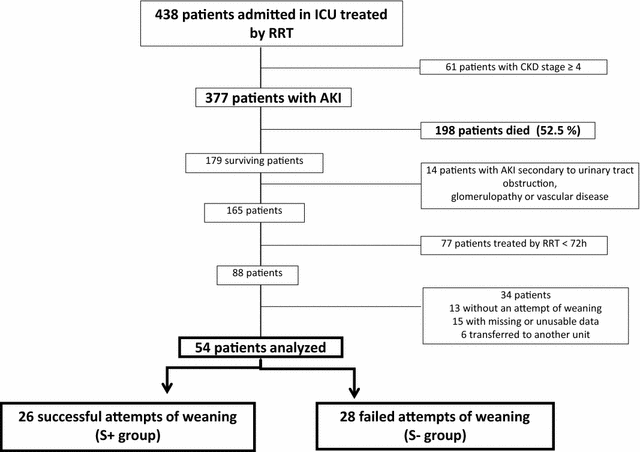Daily urinary creatinine predicts the weaning of renal replacement therapy in ICU acute kidney injury patients
- PMID: 27443673
- PMCID: PMC4956634
- DOI: 10.1186/s13613-016-0176-y
Daily urinary creatinine predicts the weaning of renal replacement therapy in ICU acute kidney injury patients
Abstract
Background: In acute kidney injury (AKI), useless continuation of renal replacement therapy (RRT) may delay renal recovery and impair patient's outcome. In this study, we aimed to identify predictive parameters that may help to a successful RRT weaning for AKI patients.
Methods: We studied 54 surviving AKI patients in which a weaning of RRT was attempted. On the day of weaning (D0) and the following 2 days (D1 and D2), SAPS II and SOFA scores, 24-h diuresis, 24-h urinary creatinine and urea (UCr and UUr), creatinine and urea generation rates (CrGR and UrGR) and clearances (CrCl and UrCl) were collected. Patients who remained free of RRT 15 days after its discontinuation were considered as successfully weaned.
Results: Twenty-six RRT weaning attempts succeeded (S+) and 28 failed (S-). Age, previous renal function, SAPS II and SOFA scores were comparable between groups. At D0, 24-h diuresis was 2300 versus 1950 ml in S+ and S-, respectively, p = 0.05. At D0, D1 and D2, 24-h UUr and UCr levels, UrCl and CrCl, and UUr/UrGR and UCr/CrGR ratios were significantly higher in S+ group. By multivariate analysis, D1 24-h UCr was the most powerful parameter that was associated with RRT weaning success with an area under the ROC curve of 0.86 [0.75-0.97] and an odds ratio of 2.01 [1.27-3.18], p = 0.003.
Conclusions: In ICU AKI, 24-h UCr appeared as an efficient and independent marker of a successful weaning of RRT. A 24-h UCr ≥5.2 mmol was associated with a successful weaning in 84 % of patients.
Keywords: Acute kidney injury; Renal replacement therapy; Urinary creatinine; Urine output; Weaning.
Figures


References
LinkOut - more resources
Full Text Sources
Other Literature Sources

